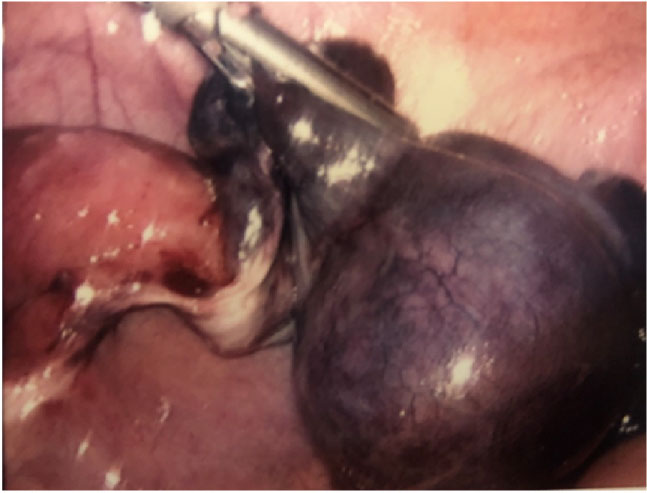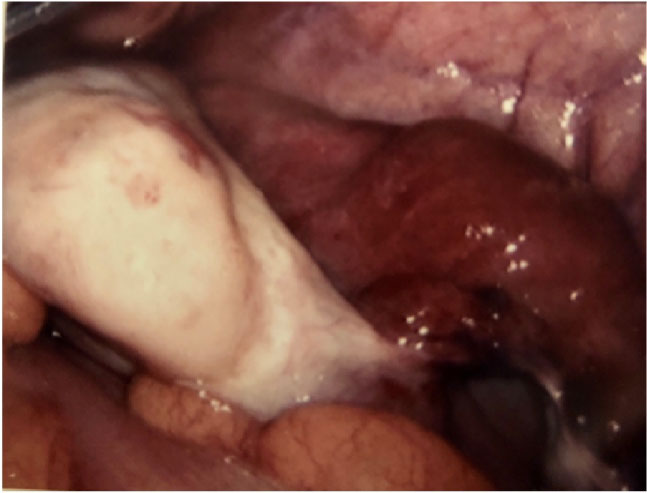Isolated torsion of the fallopian tube without epsilateral ovarian involvement is a rare cause of acute lower abdominal pain in females. The clinical presentation of tubal torsion is nonspecific and is therefore a challenge for the clinician to recognize. A definitive diagnosis can rarely be made prior to surgery. An early diagnosis may help to preserve the fallopian tube. We report a case of isolated fallopian tube torsion in a young female patient. The patient's presentation raised clinical suspicion of acute appendicitis and laparoscopy was initiated. A right sided, twisted, dilated, and necrotic fallopian tube was noted. A laparoscopic salpingectomy was performed and the patient recovered well postoperatively.
Fallopian tube, Torsion, Abdominal pain, Laparoscopy, Salpingectomy
Torsion of the adnexa is a common cause of acute lower abdominal pain in females. However, isolated torsion of the fallopian tube is very rare with an incidence of 1 in 1.5 Million women [1]. The diagnosis may be elusive due to the lack of specific symptoms and definitive diagnostic criteria. It is a gynecological emergency, where a prompt surgical intervention is necessary for the proper management. We report a rare case of isolated fallopian tube torsion in a young female patient with severe lower abdominal pain.
A 22-year-old female presented to our institution's emergency department with a two-day history of severe right-sided lower abdominal pain. The pain was associated with one episode of vomiting and decreased appetite. The patient denied any urinary or bowel symptoms. Her menstrual cycles were regular. On admission, she had a temperature of 37.2 ℃, a pulse rate of 90 beats per min. and a blood pressure of 120/70 mmHg. She was found to be tender in the right iliac fossa with guarding. The patient denied ever being sexually active, therefore a vaginal examination and a transvaginal ultrasound were not possible. A trans-abdominal pelvic ultrasound showed a normal uterus, unremarkable ovaries with normal spectral Doppler flow and a slight accumulation of fluid within the Douglas pouch. An ovoid hypoechoic cystic structure (3 × 2 cm) adjacent to the right ovary was visualised. This cystic structure was interpreted as a paraovarian cyst or hydrosalpinx and did not explain the cause of the severe abdominal pain.
Blood tests revealed a normal complete blood count except for a mild leukocytosis and slightly elevated C-reactive protein of 1.6 mg/dl (normal < 0.5 mg/dl). Urine dipstick testing revealed moderate leucocytes, erythrocytes and ketonuria. A pregnancy test was negative.
The patient's presentation raised clinical suspicion of acute appendicitis. A diagnostic laparoscopy was initiated by the general surgical team on call. Laparoscopic findings revealed an appendix with slightly increased vascular injection and a laparoscopic appendectomy was performed. A large dark blue necrotic 6 × 5 cm pelvic mass was also noted, so that the gynaecological team on-call were asked to attend. A careful examination of the mass revealed a distally dilated, twisted, necrotic right fallopian tube (Figure 1). There was no associated ipsilateral ovarian involvement (Figure 2). The contralateral Ovary, fallopian tube and the rest of the pelvis appeared normal. Untwisting failed to improve colour of the tube, so that a right salpingectomy was performed. Histopathological findings revealed a torsed dilated fallopian tube with necrosis and extensive haemorrhage. The Patient recovered uneventfully from the surgery and was discharged on the third postoperative day.
 Figure 1: Intraoperative photo showing a dilated, twisted, necrotic right fallopian tube. View Figure 1
Figure 1: Intraoperative photo showing a dilated, twisted, necrotic right fallopian tube. View Figure 1
 Figure 2: Intraoperative photo showing no associated ipsilateral ovarian involvement. View Figure 2
Figure 2: Intraoperative photo showing no associated ipsilateral ovarian involvement. View Figure 2
Isolated fallopian tube torsion is a rare cause of acute lower abdominal pain in women. The process was first described in 1890 by Bland-Sutton [2]. Isolated torsion describes a finding which occurs without any ipsilateral ovarian involvement. Most reports suggest that isolated torsion predominantly affects women of reproductive age, however it was also reported in other age-groups and in pregnancy [3-5]. Some intrinsic and extrinsic factors have been documented as predisposing factors for torsion of the fallopian tubes. Intrinsic factors include hydrosalpinx, haematosalpinx and excessive tubal length. Extrinsic factors include ovarian or paraovarian cysts, pelvic adhesions and PID [6].
The clinical presentation of tubal torsion is nonspecific and is therefore a challenge for the clinician to recognize. Acute severe lower abdominal pain is usually present. The pain can be constant and dull or paroxysmal and sharp. The symptoms may also include nausea and vomiting. The clinical examination usually reveals abdominal tenderness with or without peritoneal signs. On pelvic exam adnexa tenderness is usually present. Laboratory findings are usually nonspecific and may include leukocytosis and slightly elevated CRP.
In view of the reported cases, the diagnosis of tubal torsion can seldom be made prior to laparoscopy and there are no reliable imaging modalities [7]. In our case; this cystic mass was only partly visualised with ultrasound and a definitive diagnosis was not established prior to laparoscopy. Ultrasound may show an elongated, heterogenous cystic mass near a normal ovary with or without fluid accumulation in Douglas pouch. This may be associated with high impedance or absent flow on Doppler in the tubal structure [8].
As in our case; right sided tubal torsion has been more frequently reported in the medical literature. This may be due to increased tendency for surgical exploration in patients with acute lower abdominal pain and concern for appendicitis. In addition, it has been speculated that the left fallopian tube may be partially immobilized by its proximity to the sigmoid mesentery [9].
In conclusion, isolated fallopian tube torsion is a rare diagnosis that should be considered in every woman presenting with unilateral acute pelvic pain. Timely intervention and detorsion of the fallopian tube may help preserving it. However, given that the diagnosis and management are often delayed, the laparoscopic salpingectomy remains to be the mainstay of treatment.
The authors declare that they have no conflicts of interest and have nothing to disclose.